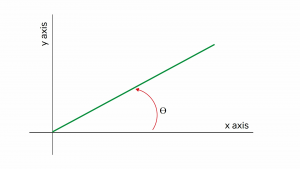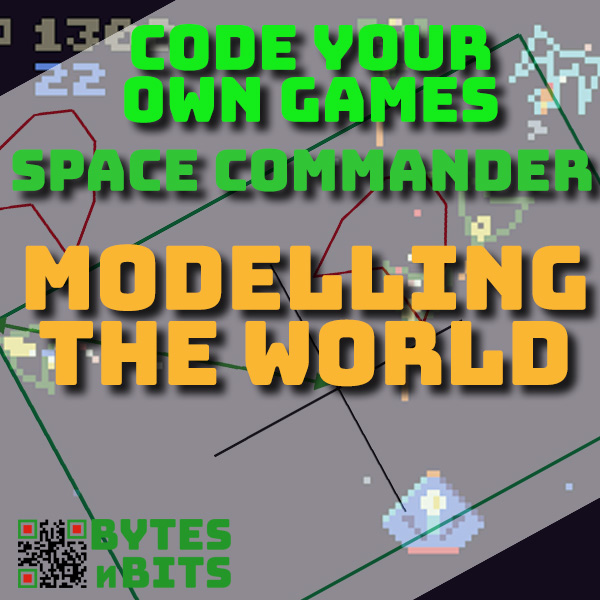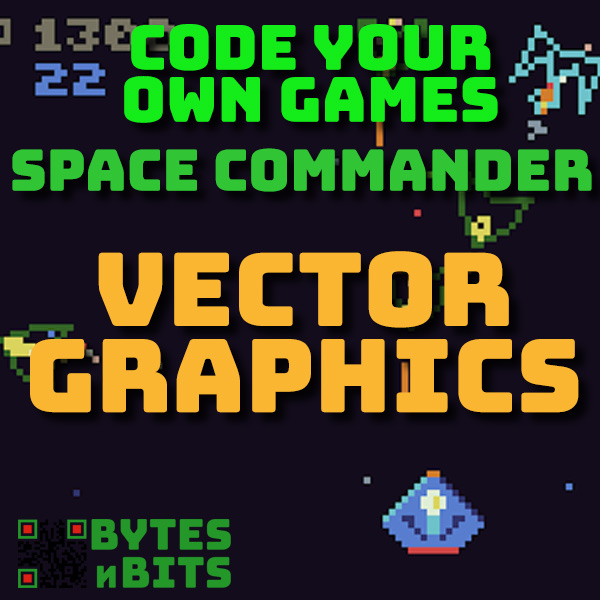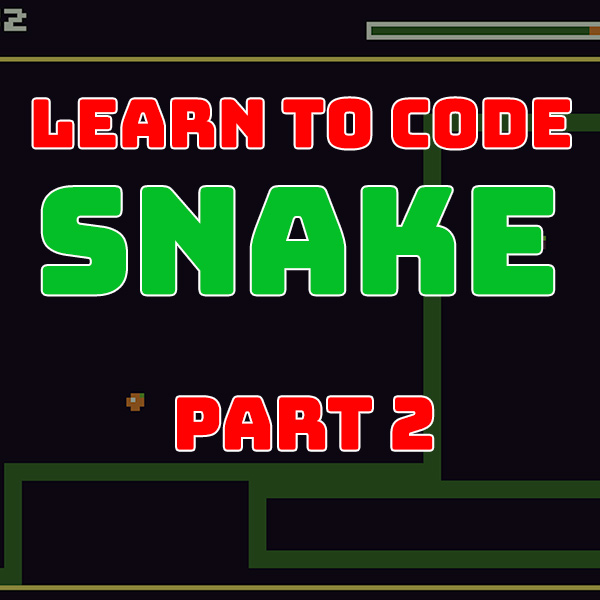
The Games That Created the Gaming Industry – The Golden Age of Video Games
16th June 2021
MAME ROMs Explained and Where To Download Them
19th July 2021Modelling the Game World in Space Commander – Learn to Code Your Own Games
The Space Commander world is modelled as a 2D space, like looking at a map from above. Objects in the game exist and move in this 2D space. All our calculations will take place in this game world. When it’s time to draw objects on the screen we’ll then map the game world to our screen world.
To describe objects’ position and motion we need a few parameters.
Position
This is the (x, y) coordinates of the object in the 2D game space. Screen coordinates tend to use the top left corner as the (0, 0) position with the positive x axis to the right and the positive y axis to the bottom. This differs from the conventional mathematical axes which have the positive x axis to the right but the positive y axis to the top.
It’s really a personal choice but I usually stick to the mathematical model unless the game world is quite simple. In this case we’ll be modelling vector quantities for velocity and acceleration, creating targeting code, etc., so using the mathematical model just makes it easier (for me) to see how angles and positions fit together.
You can make the game world match the screen world, but it doesn’t save much computing power and I can never get my head around the flipped maths!
Direction
When objects move or rotate, we need a way to describe their direction, or the way they are pointing. Using normal mathematical notation this gives us a 0 degree angle parallel to the positive x axis (i.e. horizontally to the right) with positive angles measured in an anti-clockwise direction from it.
Using this notation makes all our angle, sine, cosine and tangent calculations match with what we would expect.

Distance
As our world is imaginary, we don’t have to worry about real world distance measurements. Our positions will be easier if we use pixel coordinates, so it makes sense to measure distances in pixels as well.
Time
Again, we get to choose our units of time. We can use seconds, but a more natural measurement inside the code is the game loop. Using one game loop as one unit of time simplifies the whole time process. If we set a speed of 5 pixels per loop, we simply need to add 5 pixels each time our game loop runs.
This method can have problems. It relies on the game loop running at a set speed. TIC80 runs the game loop at 60 loop per second. If our code gets too complex each game loop takes longer than 1/60 second to complete. Our game will start to slow down, and objects will visibly move slower on the screen.
If you’ve played any retro computer games, you’ll have seen this in action.
Making the World Infinite
We want the player to be able to fly as far as they want in any direction, giving this idea of an infinite playing space. If we use a standard position, measured in pixels from a fixed origin we’ll hit a problem.
In computers, numbers have limits. If we use an integer variable to model the x coordinate of the player there will be a maximum (and minimum) value that this variable can store.
If you’re familiar with C programming, you’ll understand about using different numbers of bytes to store integers. A single byte (8 bit) integer can store values from 0 to 255. A 16-bit integer can store 0 to 65535. And so on.
If our player were to fly in one direction for a long time the coordinates may reach the limits of our variable. E.g. using 8-bit integers we can count up to 255, but adding 1 to this will result in an overflow error and our variable will wrap round to 0.
To get around this potential problem we’ll use the fact that we always want to player to be in the centre of the play area. So, we’ll use the player ship as our origin and have everything moving relative to it. So, if the player ship is travelling up, we keep the player stationary, but move everything else down, giving the same end movement.
In TIC80, which uses Lua, all numbers are represented by 64-bit floating-point numbers (real numbers with decimal places!). 10 bits are used for the exponent (the power of ten), 1 for the sign (positive and negative) and 53 for the mantissa (the significant figures of the number). This allows Lua to represent integer values from -2^53 to +2^53. We’d never reach that value, but I hope you get the idea of what we’re doing. If you ever do code in C, or even worse assembly, you’ll now know what to do!
Modelling the position and Movement of Objects
So now we know the basic parameters we’re using let’s look at how we’ll model our data.
We want to create several helper functions that will allow us to calculate positions, movement, rotations and so on. We’ll have a few different object types for our player ship, enemy ships, missiles, stars, etc.
We could write separate functions for each object to, for example, rotate it. But each of these functions would basically be the same code repeated multiple times and this isn’t good coding practice.
So, we want each operation to be handled by a single helper function which will be able to work with all our objects.
e.g. rotate_object(player_ship) and rotate_object(enemy_ship) should both work.
This relies on each object in our game storing its model data in the same format. So, when we create a class (object definition) for each game object it will inherit this data format. This is one of the principles of Object Orientated Programming (OOP) – Inheritance. Or we can think of each object providing a defined set up to its values, an OOP Interface.
If you’re interested in learning Object Orientated Programming, please check out my Python courses on Udemy.
In TIC80 we have to implement this manually, but in other languages, such as Python, we can do it through the OOP coding system.
So, each object in the game will have,
- a position attribute with x and y coordinates.
- a velocity attribute with an angle and magnitude
Moving Objects in the 2D World
The Player Ship
We’ve already seen that the player ship isn’t going to move. Its position will always be at (0, 0). But it will have a velocity with angle and magnitude.
To move the player ship, we work out its x and y position increments, dx and dy.
dx = velocity.magnitude x cos(velocity.angle) dy = velocity.magnitude x sin(velocity.angle)
We then take these away from the positions of every other object in the game.
for every_other_object position.x = position.x - dx position.y = position.y - dy next every_other_object
Every Other Object
Because we’re modelling our velocities as vectors (magnitude and direction) we can simply add our movements together to get the resultant motion. Each object has its own position and velocity, so we again calculate the incremental movement due to that motion and simply add that to its position after (or before) the movement relative to the player ship.
move object relative to player ship dx_object = velocity.magnitude x cos(velocity.angle) dy_object = velocity.magnitude x sin(velocity.angle) object.position.x = object.position.x + dx_object object.position.y = object.position.y + dy_object
This then gives the new object position in (x, y) format using the player ship as the (0, 0) origin.
Mapping the Game World to the Screen
So, all of the previous calculations allow us to move our objects around in the 2D game world where we are obeying all the mathematical norms for the axes and angles. We need to work out how to draw this on the screen.
We know that we always want the player ship pointing vertically. This is a 90 degree angle, measured from the positive x axis. If the player ship is currently travelling at an angle A, we would need to rotate the whole game map by (90 – A) degrees to get the ship pointing up the screen.
Our screen coordinates are measured from the top left corner, with x increasing to the right and y increasing down the screen. So, to map our 2D game world to the screen we need to take the game world x coordinate, but the negative y coordinate. We then need to offset this by half the screen width and half the screen height to move the origin to the centre of the screen.
So, our helper function will look like,
new_position(x,y) = rotate (game_world_position around origin by (90 - player_ship_angle) degrees) new_position.x = new_position.x + screen_offset_x new_position.y = -new_position.y + screen_offset_y
This leaves new position with the screen coordinates version of the game world position.
Mapping Object Rotation to the Screen World
As we rotate an object around the origin to position it on the screen its coordinates will change, but so will its angle of rotation.
We know that we need to rotate the game world by (90 – player_ship_angle). So, when we draw an object on the screen world its rotation will also increase by the same amount,
object_screen_angle = object_game_world_angle + (90 - A)
Coding the World Display
So, we’ve now got all the information and calculations we need to code this game world and map it to the screen.
Please have a look at the video and the code below to see how I’ve implemented our algorithms.
Play the Demo Code
Code
-- title: Space Commander
-- author: Bob Grant
-- desc:
-- script: lua
-- global variables
-- game states
state={}
state.start_screen = 0
state.playing = 1
state.player_exploding = 2
player_exploding_time = 300
state.level_up = 3
player_level_up_time = 300
state.end_game = 10
player_end_game_time = 400
state.scoreboard = 20
frame_timer = 0
-- TIC80 screen 240 x 136
screen_max_x = 239
screen_max_y = 136
screen_offset = {x=119, y=77}
player_ship_max_bullets = 6
player_ship_rotation_speed = 0.015
player_ship_max_velocity = 1.5
player_ship_acceleration = 0.05
player_ship_radius = 7
player_ship_max_health = 50
player_bullet_velocity = player_ship_max_velocity * 2
player_bullet_max_age = 60
player_bullet_damage = 1
player_ship_collide_damage = 25
player_max_lives = 3
max_player_level = 4
max_enemies = 3
total_enemies = 3
enemy_id_counter = 0
enemy_ship_max_bullets = 6
enemy_ship_rotation_speed = 0.02
enemy_ship_max_velocity = 1.5
enemy_ship_radius = 4
enemy_max_health = 5
enemy_acceleration = 0.05
enemy_bullet_velocity = enemy_ship_max_velocity * 1.5
enemy_bullet_max_age = 60
enemy_bullet_damage = 1
enemy_bullet_reload = 150
enemy_target_distance = 70
enemy_shooting_range = 80
enemy_rebound_angle = math.pi
enemy_rebound_speed = 1.0
enemy_min_visible_dist = 100
enemy_ship_respawn_dist = 2000
max_enemy_ship_type = 4
background_max_objects = 20
debug_value1=0
player_ship = {}
player_bullets = {}
enemy_bullets = {}
enemies = {}
particles={}
background={}
function init_variables(reset_enemies)
-- player ship
player_ship = {}
player_ship.ship_type=player_level
player_ship.position = {x=0, y=0}
player_ship.velocity = {magnitude=0, angle=(math.pi/2)}
player_ship.movement = {dx=0, dy=0}
player_ship.radius = player_ship_radius
player_ship.health = player_ship_max_health
player_ship.timer = 0
if(reset_enemies) then
-- respawn enemies
enemies = {}
max_enemies = (5*player_level) + 5
total_enemies = max_enemies * 3
enemy_id_counter = 0
else
-- keep existing enemies but move them a bit further away
for index,ship in ipairs(enemies) do
ship.position.x = ship.position.x *1.5
ship.position.y = ship.position.y *1.5
ship.velocity.magnitude = 0
end -- for
end
particles={}
background={}
spawn_background{}
end -- init_variables
function init_game_state()
game_state = state.start_screen
last_game_state = game_state
player_lives = player_max_lives
player_score = 0
player_level = 0
end -- init_game_state
ship_angle = 0
first_run = true
function TIC()
if first_run then
for counter = 1,4 do
spawn_enemy_test(counter, -100 +(40 * counter),50)
end -- for
first_run = false
else
cls()
update_movement_params()
update_background()
check_ship_rotation()
check_ship_acceleration()
move_enemy_ships()
draw_background()
draw_player_ship()
draw_enemy_ships()
end -- if
end -- TIC
function spawn_enemy_test(test_ship_type, x,y)
local enemy_ship = {}
enemy_ship.ship_type = test_ship_type
local spawn_angle = 0
local ship_x=x
local ship_y=y
enemy_ship.position = {x=ship_x, y=ship_y}
enemy_ship.velocity = {magnitude=0, angle=0}
enemy_ship.hit = false
enemy_ship.movement_type=0
enemy_ship.timer = 0
if(enemy_ship.ship_type == 1) then
enemy_ship.rotation_speed = 0.02
enemy_ship.max_velocity = 1.5
enemy_ship.max_health = 5
enemy_ship.health = 5
enemy_ship.acceleration = 0.05
enemy_ship.target_accuracy =0.2
enemy_ship.bullet_velocity = enemy_ship.max_velocity * 1.5
enemy_ship.bullet_max_age = 120
enemy_ship.bullet_damage = 1
enemy_ship.bullet_tracking = false
enemy_ship.bullet_rotation_speed = 0.007
enemy_ship.bullet_trail = false
enemy_ship.fire_speed = 32
enemy_ship.bullet_reload = 150
enemy_ship.bullets = 0
enemy_ship.bullet_radius = 4
enemy_ship.abs_max_bullets = 6
enemy_ship.target_distance = 50
enemy_ship.shooting_range = 80
enemy_ship.radius = 5
enemy_ship.score = 50
enemy_ship.bullets = 0
enemy_ship.max_bullets = math.floor(math.random(enemy_ship.abs_max_bullets)) + 1
elseif(enemy_ship.ship_type == 2) then
enemy_ship.rotation_speed = 0.03
enemy_ship.max_velocity = 1.7
enemy_ship.max_health = 5
enemy_ship.health = 5
enemy_ship.acceleration = 0.1
enemy_ship.target_accuracy =0.15
enemy_ship.bullet_velocity = enemy_ship.max_velocity * 1
enemy_ship.bullet_max_age = 180
enemy_ship.bullet_damage = 2
enemy_ship.bullet_tracking = true
enemy_ship.bullet_trail = true
enemy_ship.bullet_rotation_speed = 0.01
enemy_ship.fire_speed = 32
enemy_ship.bullet_reload = 200
enemy_ship.bullets = 0
enemy_ship.bullet_radius = 4
enemy_ship.abs_max_bullets = math.floor(math.random(4)) + 1
enemy_ship.target_distance = 80
enemy_ship.shooting_range = 100
enemy_ship.radius = 6
enemy_ship.score = 100
enemy_ship.bullets = 0
enemy_ship.max_bullets = math.floor(math.random(enemy_ship.abs_max_bullets)) + 1
elseif(enemy_ship.ship_type == 3) then
enemy_ship.rotation_speed = 0.03
enemy_ship.max_velocity = 1.8
enemy_ship.max_health = 5
enemy_ship.health = 5
enemy_ship.acceleration = 0.15
enemy_ship.target_accuracy =0.15
enemy_ship.bullet_velocity = enemy_ship.max_velocity * 1.5
enemy_ship.bullet_max_age = 180
enemy_ship.bullet_damage = 3
enemy_ship.bullet_tracking = false
enemy_ship.bullet_trail = false
enemy_ship.bullet_rotation_speed = 0.01
enemy_ship.fire_speed = 16
enemy_ship.bullet_reload = 200
enemy_ship.bullets = 0
enemy_ship.bullet_radius = 5
enemy_ship.abs_max_bullets = math.floor(math.random(6)) + 1
enemy_ship.target_distance = 80
enemy_ship.shooting_range = 100
enemy_ship.radius = 7
enemy_ship.score = 100
enemy_ship.bullets = 0
enemy_ship.max_bullets = math.floor(math.random(enemy_ship.abs_max_bullets)) + 1
elseif(enemy_ship.ship_type == 4) then
enemy_ship.rotation_speed = 0.03
enemy_ship.max_velocity = 2
enemy_ship.max_health = 2
enemy_ship.health = 2
enemy_ship.acceleration = 0.2
enemy_ship.target_accuracy =0.15
enemy_ship.bullet_velocity = enemy_ship.max_velocity * 1
enemy_ship.bullet_max_age = 180
enemy_ship.bullet_damage = 3
enemy_ship.bullet_tracking = true
enemy_ship.bullet_trail = true
enemy_ship.bullet_rotation_speed = 0.014
enemy_ship.fire_speed = 16
enemy_ship.bullet_reload = 200
enemy_ship.bullets = 0
enemy_ship.bullet_radius = 5
enemy_ship.abs_max_bullets = math.floor(math.random(6)) + 1
enemy_ship.target_distance = 80
enemy_ship.shooting_range = 100
enemy_ship.radius = 8
enemy_ship.score = 200
enemy_ship.bullets = 0
enemy_ship.max_bullets = math.floor(math.random(enemy_ship.abs_max_bullets)) + 1
end
table.insert(enemies,enemy_ship)
end --spawn ememy
function update_movement_params()
player_ship.movement.dx=
player_ship.velocity.magnitude
* math.cos(player_ship.velocity.angle)
player_ship.movement.dy=
player_ship.velocity.magnitude
* math.sin(player_ship.velocity.angle)
end -- update_movement_params
function check_ship_rotation()
if(btn(2)) then
player_ship.velocity.angle=
player_ship.velocity.angle + player_ship_rotation_speed
elseif(btn(3)) then
player_ship.velocity.angle=
player_ship.velocity.angle - player_ship_rotation_speed
end
player_ship.velocity.angle =
wrap_angle(player_ship.velocity.angle)
end --check_ship_rotation
function check_ship_acceleration()
if(btn(0)) then
player_ship.velocity.magnitude=
player_ship.velocity.magnitude + player_ship_acceleration
if (player_ship.velocity.magnitude > player_ship_max_velocity) then player_ship.velocity.magnitude = player_ship_max_velocity end
elseif(btn(1)) then
player_ship.velocity.magnitude=
player_ship.velocity.magnitude - player_ship_acceleration
if (player_ship.velocity.magnitude < (-player_ship_max_velocity/2)) then player_ship.velocity.magnitude = (-player_ship_max_velocity/2) end
end
-- check for stationary
if math.abs(player_ship.velocity.magnitude)
< (player_ship_acceleration * 0.9) then
player_ship.velocity.magnitude = 0
end
end --check_ship_acceleration
function move_relative_to_player(point)
-- moves the point not the ship position
point.x=point.x - player_ship.movement.dx
point.y=point.y - player_ship.movement.dy
return point
end -- move_player_ship
function move_by_velocity(point, velocity)
-- moves the point
local dx=velocity.magnitude * math.cos(velocity.angle)
local dy=velocity.magnitude * math.sin(velocity.angle)
point.x=point.x + dx
point.y=point.y + dy
return point
end
function move_enemy_ships()
for index, ship in ipairs(enemies) do
ship.position = move_relative_to_player(ship.position)
end -- for
end -- move_enemy_ships
function spawn_enemy()
if ((#enemies < max_enemies) and (enemy_id_counter < total_enemies)) then
enemy_ship = {}
enemy_ship.ship_type = 1 + (math.floor(math.random() * (player_level + 1)))
if (enemy_ship.ship_type > max_enemy_ship_type) then
enemy_ship.ship_type = max_enemy_ship_type
end
local spawn_angle = math.random() * (2 * math.pi)
local spawn_distance = math.floor(math.random(500)) + 1000
local ship_x=spawn_distance * math.cos(spawn_angle)
local ship_y=spawn_distance * math.sin(spawn_angle)
enemy_ship.id = enemy_id_counter
enemy_id_counter = enemy_id_counter + 1
enemy_ship.position = {x=ship_x, y=ship_y}
enemy_ship.velocity = {magnitude=0, angle=0}
enemy_ship.hit = false
enemy_ship.movement_type=0
enemy_ship.timer = 0
if(enemy_ship.ship_type == 1) then
enemy_ship.rotation_speed = 0.02
enemy_ship.max_velocity = 1.5
enemy_ship.max_health = 5
enemy_ship.health = 5
enemy_ship.acceleration = 0.05
enemy_ship.target_accuracy =0.2
enemy_ship.bullet_velocity = enemy_ship.max_velocity * 1.5
enemy_ship.bullet_max_age = 120
enemy_ship.bullet_damage = 1
enemy_ship.bullet_tracking = false
enemy_ship.bullet_rotation_speed = 0.007
enemy_ship.bullet_trail = false
enemy_ship.fire_speed = 32
enemy_ship.bullet_reload = 150
enemy_ship.bullets = 0
enemy_ship.bullet_radius = 4
enemy_ship.abs_max_bullets = 6
enemy_ship.target_distance = 50
enemy_ship.shooting_range = 80
enemy_ship.radius = 5
enemy_ship.score = 50
enemy_ship.bullets = 0
enemy_ship.max_bullets = math.floor(math.random(enemy_ship.abs_max_bullets)) + 1
elseif(enemy_ship.ship_type == 2) then
enemy_ship.rotation_speed = 0.03
enemy_ship.max_velocity = 1.7
enemy_ship.max_health = 5
enemy_ship.health = 5
enemy_ship.acceleration = 0.1
enemy_ship.target_accuracy =0.15
enemy_ship.bullet_velocity = enemy_ship.max_velocity * 1
enemy_ship.bullet_max_age = 180
enemy_ship.bullet_damage = 2
enemy_ship.bullet_tracking = true
enemy_ship.bullet_trail = true
enemy_ship.bullet_rotation_speed = 0.01
enemy_ship.fire_speed = 32
enemy_ship.bullet_reload = 200
enemy_ship.bullets = 0
enemy_ship.bullet_radius = 4
enemy_ship.abs_max_bullets = math.floor(math.random(4)) + 1
enemy_ship.target_distance = 80
enemy_ship.shooting_range = 100
enemy_ship.radius = 6
enemy_ship.score = 100
enemy_ship.bullets = 0
enemy_ship.max_bullets = math.floor(math.random(enemy_ship.abs_max_bullets)) + 1
elseif(enemy_ship.ship_type == 3) then
enemy_ship.rotation_speed = 0.03
enemy_ship.max_velocity = 1.8
enemy_ship.max_health = 5
enemy_ship.health = 5
enemy_ship.acceleration = 0.15
enemy_ship.target_accuracy =0.15
enemy_ship.bullet_velocity = enemy_ship.max_velocity * 1.5
enemy_ship.bullet_max_age = 180
enemy_ship.bullet_damage = 3
enemy_ship.bullet_tracking = false
enemy_ship.bullet_trail = false
enemy_ship.bullet_rotation_speed = 0.01
enemy_ship.fire_speed = 16
enemy_ship.bullet_reload = 200
enemy_ship.bullets = 0
enemy_ship.bullet_radius = 5
enemy_ship.abs_max_bullets = math.floor(math.random(6)) + 1
enemy_ship.target_distance = 80
enemy_ship.shooting_range = 100
enemy_ship.radius = 7
enemy_ship.score = 100
enemy_ship.bullets = 0
enemy_ship.max_bullets = math.floor(math.random(enemy_ship.abs_max_bullets)) + 1
elseif(enemy_ship.ship_type == 4) then
enemy_ship.rotation_speed = 0.03
enemy_ship.max_velocity = 2
enemy_ship.max_health = 2
enemy_ship.health = 2
enemy_ship.acceleration = 0.2
enemy_ship.target_accuracy =0.15
enemy_ship.bullet_velocity = enemy_ship.max_velocity * 1
enemy_ship.bullet_max_age = 180
enemy_ship.bullet_damage = 3
enemy_ship.bullet_tracking = true
enemy_ship.bullet_trail = true
enemy_ship.bullet_rotation_speed = 0.014
enemy_ship.fire_speed = 16
enemy_ship.bullet_reload = 200
enemy_ship.bullets = 0
enemy_ship.bullet_radius = 5
enemy_ship.abs_max_bullets = math.floor(math.random(6)) + 1
enemy_ship.target_distance = 80
enemy_ship.shooting_range = 100
enemy_ship.radius = 8
enemy_ship.score = 200
enemy_ship.bullets = 0
enemy_ship.max_bullets = math.floor(math.random(enemy_ship.abs_max_bullets)) + 1
end
table.insert(enemies,enemy_ship)
end --if
end --spawn ememy
function spawn_background()
-- initial background in player area
background = {}
for stars=1, background_max_objects do
star_x = math.random(screen_max_x + (2*player_ship_max_velocity)) - player_ship_max_velocity - math.floor(screen_max_x/2)
star_y = math.random(screen_max_y + (2*player_ship_max_velocity)) - player_ship_max_velocity - math.floor(screen_max_y/2)
generate_background_object(0, star_x, star_y)
end --for
end -- spawn_background
function update_background()
local new_object=false
for index,object in ipairs(background) do
-- update for player moveent
object.position = move_relative_to_player(object.position)
object.velocity.angle =
object.velocity.angle + object.rotation_speed
-- wrap objects going out of working background area
new_object=false
if (object.position.x < -(player_ship_max_velocity + math.floor(screen_max_x/2))) then
object.position.x = math.floor(screen_max_x/2) + player_ship_max_velocity
new_object=true
elseif (object.position.x > (player_ship_max_velocity + math.floor(screen_max_x/2))) then
object.position.x = -(math.floor(screen_max_x/2) + player_ship_max_velocity)
new_object=true
end
if (object.position.y < -(player_ship_max_velocity + math.floor(screen_max_y/2))) then
object.position.y = math.floor(screen_max_y/2) + player_ship_max_velocity
new_object=true
elseif (object.position.y > math.floor(screen_max_y/2) + player_ship_max_velocity) then
object.position.y = -(math.floor(screen_max_y/2) + player_ship_max_velocity)
new_object=true
end
if (new_object) then
object = change_background_object(object)
end
end -- for
end -- update_background
function generate_background_object(type, object_x, object_y)
if (#background < background_max_objects) then
-- make new object
object = {}
object.type = math.floor(math.random(10)) + 1
if (object.type>2) then
object.type = 1
end
object.position={}
object.position.x = object_x
object.position.y = object_y
object.velocity={}
object.velocity.magnitude=0
object.velocity.angle=0
object.rotation_speed = (math.random(4) - 2) /100
object.age=0
object.colour = math.floor(math.random(15)) + 1
table.insert(background, object)
end
end -- generate_background_object
function change_background_object(object)
object.type = math.floor(math.random(10)) + 1
if (object.type>2) then
object.type = 1
end
object.age=0
object.rotation_speed = (math.random(4) - 2) / 100
object.colour = math.floor(math.random(15)) + 1
return object
end -- change_background_object
function update_end_game()
end -- update_end_game
function update_scoreboard()
end -- update_scoreboard
function draw_start_screen()
cls()
print("SPACE COMMANDER", 30,30, 6,FALSE,2)
spr(16,85,50,-1,3,0,0,2,2)
print("PRESS Z TO PLAY", 35,110, 15,FALSE,2)
end -- draw_start_screen
function draw_playing()
cls()
--print(player_ship.health, 0,0)
--print(angle_to_player.." - "..distance_to_player, 0,8)
draw_background()
draw_bullets()
draw_player_ship()
draw_enemy_ships()
draw_particles()
draw_radar()
draw_dashboard()
end -- draw_playing
function draw_background()
for index,object in ipairs(background) do
draw_background_object(object)
end -- for
end -- draw_background
function draw_background_object(object)
local position = {}
local velocity = {}
position = translate_position_to_display(object.position)
velocity = translate_velocity_to_display(object.velocity)
if (object.type == 2) then
pix(position.x, position.y, object.colour)
pix(position.x+1, position.y, object.colour)
pix(position.x, position.y+1, object.colour)
pix(position.x+1, position.y+1, object.colour)
elseif (object.type==3) then
draw_object(10,{x=position.x, y=position.y},velocity.angle)
else
pix(position.x, position.y, object.colour)
end
end -- draw_background_object
function draw_player_ship()
local ship_icon = (player_level*2)+16
if(ship_icon > 22) then
ship_icon=22
end
spr(ship_icon,
screen_offset.x-8, screen_offset.y-8,
0,1,0,0,2,2)
end -- draw_player_ship
function draw_enemy_ships()
local position = {}
local velocity = {}
for index,ship in ipairs(enemies) do
position = translate_position_to_display(ship.position)
velocity = translate_velocity_to_display(ship.velocity)
ship.screen_position = position
if ((math.abs(ship.position.x ) < enemy_min_visible_dist) and (math.abs(ship.position.y) < enemy_min_visible_dist)) then
circ(position.x, position.y,ship.radius,0)
draw_object(ship.ship_type,position,velocity.angle)
end
end -- for
end --draw_enemy_ships
function draw_object(object_type, origin, angle)
local object_shape = get_object_shape(object_type)
local point={}
local last_point={}
local rotated_point
for index,point in ipairs(object_shape) do
-- rotate object point around {0,0}
rotated_point = rotate_point({x=0, y=0}, point, angle)
point.x = rotated_point.x
point.y = rotated_point.y
-- move object point to correct screen position
point.x = point.x + origin.x
point.y = -point.y + origin.y
if (point.newline) then
last_point = point
else
line(last_point.x, last_point.y, point.x, point.y, point.colour)
last_point=point
end
end -- for
end -- draw_object
function get_object_shape(object_type)
local object_shape = {}
if (object_type == 0) then
-- player object_type
object_shape = {}
table.insert(object_shape, {y=-5,x=-5, newline=true, colour=5})
table.insert(object_shape, {y=-5,x=0, newline=false, colour=5})
table.insert(object_shape, {y=0, x=5, newline=false, colour=5})
table.insert(object_shape, {y=5, x=0, newline=false, colour=5})
table.insert(object_shape, {y=5, x=-5, newline=false, colour=5})
table.insert(object_shape, {y=2, x=-5, newline=false, colour=5})
table.insert(object_shape, {y=2, x=-2, newline=false, colour=5})
table.insert(object_shape, {y=-2, x=-2, newline=false, colour=5})
table.insert(object_shape, {y=-2, x=-5, newline=false, colour=5})
table.insert(object_shape, {y=-5, x=-5, newline=false, colour=5})
table.insert(object_shape, {y=5, x=-5, newline=true, colour=5})
table.insert(object_shape, {y=2, x=-5, newline=false, colour=14})
table.insert(object_shape, {y=-2, x=-5, newline=true, colour=5})
table.insert(object_shape, {y=-5, x=-5, newline=false, colour=14})
elseif(object_type == 1) then
-- level 1 ship
object_shape = {}
table.insert(object_shape, {x=-5, y=-5,newline=true, colour=5})
table.insert(object_shape, {x=0, y=-4,newline=false, colour=5})
table.insert(object_shape, {x=5, y=0, newline=false, colour=5})
table.insert(object_shape, {x=0, y=4, newline=false, colour=5})
table.insert(object_shape, {x=-5, y=5, newline=false, colour=5})
table.insert(object_shape, {x=-4, y=3, newline=false, colour=5})
table.insert(object_shape, {x=-3, y=0, newline=false, colour=5})
table.insert(object_shape, {x=-4, y=-3, newline=false, colour=5})
table.insert(object_shape, {x=-5, y=-5, newline=false, colour=5})
table.insert(object_shape, {x=4, y=0, newline=true, colour=14})
table.insert(object_shape, {x=2, y=1, newline=false, colour=14})
table.insert(object_shape, {x=0, y=0, newline=false, colour=14})
table.insert(object_shape, {x=2, y=-1, newline=false, colour=14})
table.insert(object_shape, {x=4, y=0, newline=false, colour=14})
table.insert(object_shape, {x=0, y=0, newline=false, colour=14})
elseif(object_type == 2) then
-- level 2 ship
object_shape = {}
table.insert(object_shape, {x=-6, y=-6,newline=true, colour=13})
table.insert(object_shape, {x=3, y=-6,newline=false, colour=13})
table.insert(object_shape, {x=-2, y=-4, newline=false, colour=13})
table.insert(object_shape, {x=-3, y=-2, newline=false, colour=13})
table.insert(object_shape, {x=4, y=2, newline=false, colour=13})
table.insert(object_shape, {x=6, y=0, newline=false, colour=13})
table.insert(object_shape, {x=4, y=-2, newline=false, colour=13})
table.insert(object_shape, {x=-3, y=2, newline=false, colour=13})
table.insert(object_shape, {x=-2, y=4, newline=false, colour=13})
table.insert(object_shape, {x=3, y=6, newline=false, colour=13})
table.insert(object_shape, {x=-6, y=6, newline=false, colour=13})
table.insert(object_shape, {x=-4, y=0, newline=false, colour=13})
table.insert(object_shape, {x=-6, y=-6, newline=false, colour=13})
table.insert(object_shape, {x=5, y=0, newline=true, colour=9})
table.insert(object_shape, {x=3, y=1, newline=false, colour=9})
table.insert(object_shape, {x=1, y=0, newline=false, colour=9})
table.insert(object_shape, {x=3, y=-1, newline=false, colour=9})
table.insert(object_shape, {x=5, y=0, newline=false, colour=9})
table.insert(object_shape, {x=1, y=0, newline=false, colour=9})
elseif(object_type == 3) then
-- level 3 ship
object_shape = {}
table.insert(object_shape, {x=-6, y=-0,newline=true, colour=6})
table.insert(object_shape, {x=8, y=-3,newline=false, colour=6})
table.insert(object_shape, {x=6, y=0, newline=false, colour=6})
table.insert(object_shape, {x=8, y=3, newline=false, colour=6})
table.insert(object_shape, {x=-6, y=0, newline=false, colour=6})
table.insert(object_shape, {x=-4, y=1, newline=true, colour=6})
table.insert(object_shape, {x=-2, y=6, newline=false, colour=6})
table.insert(object_shape, {x=2, y=2, newline=false, colour=6})
table.insert(object_shape, {x=-4, y=1, newline=true, colour=6})
table.insert(object_shape, {x=0, y=3, newline=false, colour=6})
table.insert(object_shape, {x=-4, y=1, newline=true, colour=6})
table.insert(object_shape, {x=-2, y=-6, newline=false, colour=6})
table.insert(object_shape, {x=2, y=-2, newline=false, colour=6})
table.insert(object_shape, {x=-4, y=-1, newline=true, colour=6})
table.insert(object_shape, {x=0, y=-3, newline=false, colour=6})
table.insert(object_shape, {x=5, y=0, newline=true, colour=14})
table.insert(object_shape, {x=3, y=1, newline=false, colour=14})
table.insert(object_shape, {x=1, y=0, newline=false, colour=14})
table.insert(object_shape, {x=3, y=-1, newline=false, colour=14})
table.insert(object_shape, {x=5, y=0, newline=false, colour=14})
table.insert(object_shape, {x=1, y=0, newline=false, colour=14})
elseif(object_type == 4) then
-- level 4 ship
object_shape = {}
table.insert(object_shape, {x=-7, y=0,newline=true, colour=8})
table.insert(object_shape, {x=-4, y=1,newline=false, colour=8})
table.insert(object_shape, {x=-2, y=4,newline=false, colour=8})
table.insert(object_shape, {x=-4, y=4,newline=false, colour=8})
table.insert(object_shape, {x=-6, y=6,newline=false, colour=8})
table.insert(object_shape, {x=-7, y=9,newline=false, colour=8})
table.insert(object_shape, {x=-1, y=9,newline=false, colour=8})
table.insert(object_shape, {x=2, y=7,newline=false, colour=8})
table.insert(object_shape, {x=5, y=4,newline=false, colour=8})
table.insert(object_shape, {x=7, y=0,newline=false, colour=8})
table.insert(object_shape, {x=5, y=-4,newline=false, colour=8})
table.insert(object_shape, {x=2, y=-7,newline=false, colour=8})
table.insert(object_shape, {x=-1, y=-9,newline=false, colour=8})
table.insert(object_shape, {x=-7, y=-9,newline=false, colour=8})
table.insert(object_shape, {x=-6, y=-6,newline=false, colour=8})
table.insert(object_shape, {x=-4, y=-4,newline=false, colour=8})
table.insert(object_shape, {x=-2, y=-4,newline=false, colour=8})
table.insert(object_shape, {x=-4, y=-1,newline=false, colour=8})
table.insert(object_shape, {x=-7, y=-0,newline=false, colour=8})
table.insert(object_shape, {x=5, y=4,newline=true, colour=8})
table.insert(object_shape, {x=3, y=1,newline=false, colour=8})
table.insert(object_shape, {x=2, y=0,newline=false, colour=8})
table.insert(object_shape, {x=3, y=-1,newline=false, colour=8})
table.insert(object_shape, {x=5, y=-4,newline=false, colour=8})
elseif (object_type == 10) then --background star
object_shape = {}
table.insert(object_shape, {y=0,x=1, newline=true, colour=10})
table.insert(object_shape, {y=0,x=-1, newline=false, colour=math.floor(math.random(15)) + 1})
table.insert(object_shape, {y=1, x=0, newline=true, colour=10})
table.insert(object_shape, {y=-1, x=0, newline=false, colour=math.floor(math.random(15)) + 1})
elseif (object_type == 20) then -- player bullet
object_shape = {}
table.insert(object_shape, {x=0,y=0, newline=true, colour=10})
table.insert(object_shape, {x=5,y=0, newline=false, colour=10})
elseif (object_type == 21) then -- player bullet
object_shape = {}
table.insert(object_shape, {x=0,y=0, newline=true, colour=math.floor(math.random(4))+7})
table.insert(object_shape, {x=3,y=0, newline=false, colour=math.floor(math.random(4))+7})
table.insert(object_shape, {x=0,y=0, newline=true, colour=math.floor(math.random(4))+7})
table.insert(object_shape, {x=-3,y=0, newline=false, colour=math.floor(math.random(4))+7})
table.insert(object_shape, {x=0,y=0, newline=true, colour=math.floor(math.random(4))+7})
table.insert(object_shape, {x=0,y=3, newline=false, colour=math.floor(math.random(4))+7})
table.insert(object_shape, {x=0,y=0, newline=true, colour=math.floor(math.random(4))+7})
table.insert(object_shape, {x=0,y=-3, newline=false, colour=math.floor(math.random(4))+7})
table.insert(object_shape, {x=0,y=0, newline=true, colour=math.floor(math.random(4))+7})
table.insert(object_shape, {x=-2,y=-2, newline=false, colour=math.floor(math.random(4))+7})
table.insert(object_shape, {x=0,y=0, newline=true, colour=math.floor(math.random(4))+7})
table.insert(object_shape, {x=2,y=-2, newline=false, colour=math.floor(math.random(4))+7})
table.insert(object_shape, {x=0,y=0, newline=true, colour=math.floor(math.random(4))+7})
table.insert(object_shape, {x=2,y=2, newline=false, colour=math.floor(math.random(4))+7})
table.insert(object_shape, {x=0,y=0, newline=true, colour=math.floor(math.random(4))+7})
table.insert(object_shape, {x=-2,y=2, newline=false, colour=math.floor(math.random(4))+7})
elseif (object_type == 30) then -- enemy bullet type1
object_shape = {}
table.insert(object_shape, {x=0,y=0, newline=true, colour=9})
table.insert(object_shape, {x=5,y=0, newline=false, colour=9})
elseif (object_type == 31) then -- enemy bullet type2
object_shape = {}
table.insert(object_shape, {x=0,y=0, newline=true, colour=10})
table.insert(object_shape, {x=5,y=0, newline=false, colour=10})
table.insert(object_shape, {x=0,y=1, newline=true, colour=10})
table.insert(object_shape, {x=0,y=-1, newline=false, colour=10})
table.insert(object_shape, {x=3,y=1, newline=true, colour=10})
table.insert(object_shape, {x=3,y=-1, newline=false, colour=10})
elseif (object_type == 32) then -- enemy bullet type3
object_shape = {}
table.insert(object_shape, {x=0,y=0, newline=true, colour=get_fire_colour()})
table.insert(object_shape, {x=3,y=0, newline=false, colour=get_fire_colour()})
table.insert(object_shape, {x=0,y=0, newline=true, colour=get_fire_colour()})
table.insert(object_shape, {x=-3,y=0, newline=false, colour=get_fire_colour()})
table.insert(object_shape, {x=0,y=0, newline=true, colour=get_fire_colour()})
table.insert(object_shape, {x=0,y=3, newline=false, colour=get_fire_colour()})
table.insert(object_shape, {x=0,y=0, newline=true, colour=get_fire_colour()})
table.insert(object_shape, {x=0,y=-3, newline=false, colour=get_fire_colour()})
table.insert(object_shape, {x=0,y=0, newline=true, colour=get_fire_colour()})
table.insert(object_shape, {x=-2,y=-2, newline=false, colour=get_fire_colour()})
table.insert(object_shape, {x=0,y=0, newline=true, colour=get_fire_colour()})
table.insert(object_shape, {x=2,y=-2, newline=false, colour=get_fire_colour()})
table.insert(object_shape, {x=0,y=0, newline=true, colour=get_fire_colour()})
table.insert(object_shape, {x=2,y=2, newline=false, colour=get_fire_colour()})
table.insert(object_shape, {x=0,y=0, newline=true, colour=get_fire_colour()})
table.insert(object_shape, {x=-2,y=2, newline=false, colour=get_fire_colour()})
elseif (object_type == 33) then -- enemy bullet type4
object_shape = {}
table.insert(object_shape, {x=0,y=0, newline=true, colour=get_fire_colour()})
table.insert(object_shape, {x=3,y=0, newline=false, colour=get_fire_colour()})
table.insert(object_shape, {x=0,y=0, newline=true, colour=get_fire_colour()})
table.insert(object_shape, {x=-3,y=0, newline=false, colour=get_fire_colour()})
table.insert(object_shape, {x=0,y=0, newline=true, colour=get_fire_colour()})
table.insert(object_shape, {x=0,y=3, newline=false, colour=get_fire_colour()})
table.insert(object_shape, {x=0,y=0, newline=true, colour=get_fire_colour()})
table.insert(object_shape, {x=0,y=-3, newline=false, colour=get_fire_colour()})
table.insert(object_shape, {x=0,y=0, newline=true, colour=get_fire_colour()})
table.insert(object_shape, {x=-2,y=-2, newline=false, colour=get_fire_colour()})
table.insert(object_shape, {x=0,y=0, newline=true, colour=get_fire_colour()})
table.insert(object_shape, {x=2,y=-2, newline=false, colour=get_fire_colour()})
table.insert(object_shape, {x=0,y=0, newline=true, colour=get_fire_colour()})
table.insert(object_shape, {x=2,y=2, newline=false, colour=get_fire_colour()})
table.insert(object_shape, {x=0,y=0, newline=true, colour=get_fire_colour()})
table.insert(object_shape, {x=-2,y=2, newline=false, colour=get_fire_colour()})
end
return object_shape
end -- get_object_shape
function get_fire_colour()
-- returns a fire colour
local colours = {6,8,12,14,15}
return colours[math.random(#colours)]
end -- get_fire_colour
function rotate_point(origin, point, angle)
local transposed_point = {}
transposed_point.x = point.x - origin.x
transposed_point.y = point.y - origin.y
local rotated_point = {}
rotated_point.x =
(transposed_point.x * math.cos(angle))
- (transposed_point.y * math.sin(angle))
rotated_point.y =
(transposed_point.y * math.cos(angle))
+ (transposed_point.x * math.sin(angle))
-- update provided point
rotated_point.x = rotated_point.x + origin.x
rotated_point.y = rotated_point.y + origin.y
return rotated_point
end -- rotate_point
function translate_position_to_display(position)
local new_position = {}
local adjusted_angle = (math.pi/2) - player_ship.velocity.angle
adjusted_angle = wrap_angle(adjusted_angle)
new_position =
rotate_point({x=0,y=0}, position, adjusted_angle)
new_position.x = new_position.x + screen_offset.x
new_position.y = -new_position.y + screen_offset.y
return new_position
end -- translate_position_to_display
function translate_velocity_to_display(velocity)
local new_velocity={}
new_velocity.angle =
velocity.angle + (math.pi/2) - player_ship.velocity.angle
new_velocity.angle = wrap_angle(new_velocity.angle)
new_velocity.magnitude = velocity.magnitude
return new_velocity
end -- translate_velocity_to_display
-- add two angle / magnitude vectors
function add_velocities(v1, v2)
local dx1=v1.magnitude * math.cos(v1.angle)
local dy1=v1.magnitude * math.sin(v1.angle)
local dx2=v2.magnitude * math.cos(v2.angle)
local dy2=v2.magnitude * math.sin(v2.angle)
local dx = dx1 + dx2
local dy = dy1 + dy2
local velocity = {}
velocity.dx = dx
velocity.dy = dy
velocity.angle = math.atan2(dy, dx)
velocity.magnitude = math.sqrt((dx*dx) + (dy*dy))
return velocity
end
function get_angle_to_target(subject, target)
local dx = target.position.x-subject.position.x
local dy = target.position.y-subject.position.y
local angle_to_target = math.atan2(dy, dx)
angle_to_target = wrap_angle(angle_to_target)
return angle_to_target
end --get_angle_to_target
function wrap_angle(angle)
local new_angle = angle
if (new_angle > (2*math.pi)) then
new_angle = new_angle - (2*math.pi)
elseif(new_angle < 0) then
new_angle = new_angle + (2*math.pi)
end --if
return new_angle
end -- wrap_angle
function add_angles(angle1, angle2)
local new_angle = angle1 + angle2
new_angle = wrap_angle(new_angle)
return new_angle
end -- add_angles
function get_angle_inc(target_angle, current_angle, target_accuracy)
local increment = 0
local angle_diff = target_angle - current_angle
if (angle_diff < 0) then
angle_diff = (2*math.pi) + angle_diff
end -- if
if (math.abs(angle_diff) < target_accuracy) then
increment = 0
elseif (angle_diff > math.pi) then
increment = -1
else
increment=1
end -- if
return increment
end -- get_angle_inc
-- first run code
-- run init functions to set up game
init_game_state()
init_variables(true)




